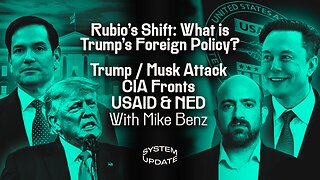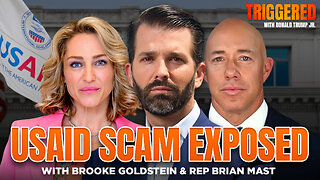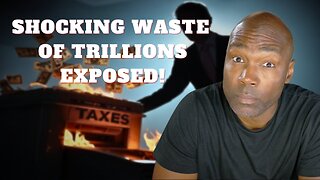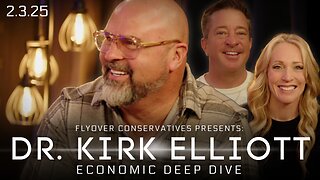Premium Only Content

Episode 1997: Archbishop Annibale Bugnini the destroyer of the Catholic Church
Proverbs 17:28
"Even fools are thought wise if they keep silent, and discerning if they hold their tongues."
or
"Those who are silent when they ought to speak are guilty of falsehood." St. Augustine of Hippo
Also
Matthew 5:37 "Let what you say be simply 'Yes' or 'No'; anything more than this comes from evil."
But now to the point of this episode. I mentioned in a previous episode that Annibale Bugnini Catholic Archbishop during the pontificate of Pope Paul 6th was the signal most destructive force in the Catholic Church and yet most Catholics know nothing about him. Well I will educate you on him and you do not have to believe me, go do your own research.
But fasten your proverbial seats belts because this is going to be a bumpy ride.
Overview
Annibale Bugnini CM (14 June 1912 – 3 July 1982) was a Catholic prelate. Ordained in 1936 and named archbishop in 1972, he was secretary of the commission that worked on the reform of the Roman Rite that followed the Second Vatican Council. Both critics and proponents of the changes made to the Mass, the Liturgy of the hours and other liturgical practices before and after Vatican II consider him a dominant force in these efforts.[1] He held several other posts in the Roman Curia and ended his career as papal nuncio to Iran, where he acted as an intermediary during the Iran hostage crisis of 1979 to 1981.
Annibale Bugnini was born in Civitella del Lago in Umbria.
He completed his doctorate in sacred theology at the Pontifical University of St. Thomas Aquinas Angelicum in 1938 with a dissertation entitled De liturgia eiusque momento in Concilio Tridentino.
He spent ten years in parish work in a suburb of Rome. In 1947 Bugnini became involved in the production of the missionary publications of his order and became the editor of Ephemerides Liturgicæ, a scholarly journal founded in 1887 and dedicated to the study of the Catholic liturgy. Starting in 1949, he taught liturgical studies at the Pontifical Urban College (now the Pontifical Urban University). He later became a professor at the Pontifical Lateran University.
Curial career
On 28 May 1948, Pope Pius XII appointed Bugnini secretary to the Commission for Liturgical Reform, which created a revised rite for the Easter Vigil in 1951 and revised ceremonies for the rest of Holy Week in 1955. The commission also made changes in 1955 to the rubrics of the Mass and office, suppressing many of the Church's octaves and a number of vigils, and abolishing the first vespers of most feasts. In 1960 the commission modified the Code of Rubrics, which led to new editions of the Roman Breviary in 1961 and of the Roman Missal in 1962.
On 25 January 1959, Pope John XXIII announced his plan to convene the Second Vatican Council. On 6 June 1960 Fr. Bugnini was named secretary of the Pontifical Preparatory Commission on the Liturgy. This body produced the first drafts of the document that, after many changes, would become the council's Constitution on the Sacred Liturgy (1963). When the council convened in October 1962, the Preparatory Commission was succeeded by the Conciliar Commission on the Sacred Liturgy, on which Bugnini was assigned the role of a peritus (expert). At the same time, Bugnini was removed from the chair of Liturgy at the Pontifical Lateran University because, in the words of Piero Marini, "his liturgical ideas were seen as too progressive." In his posthumously published memoirs, Second Vatican Council consultant Louis Bouyer called Bugnini "a man as bereft of culture as he was of basic honesty."
The council and Pope Paul VI approved the Constitution on the Liturgy on 4 December 1963. On 30 January 1964, the Pope appointed Bugnini secretary of the Council for the Implementation of the Constitution on the Liturgy. Bugnini was appointed the secretary of the Congregation for Divine Worship by Pope Paul in May 1969. In January 1965, he had become an undersecretary in the Congregation of Rites responsible for causes for beatification and canonization.
Diplomatic service
On 4 January 1976, Pope Paul named Bugnini pro-nuncio to Iran. Bugnini studied the country, its history, and traditions. The results of his researches appeared in 1981 as La Chiesa in Iran (The Church in Iran).
In 1979, Bugnini tried unsuccessfully to obtain, in the name of the Pope, the release of the American hostages being held at the United States embassy by followers of the Ayatollah Ruhollah Khomeini. He met with Khomeini to deliver Pope John Paul II's appeal for the release of the hostages.
Death
Bugnini died of natural causes at the Pope Pius XI Clinic in Rome on 3 July 1982.
His detailed account of the work to which he devoted most of his career, The Reform of the Liturgy 1948-1975, appeared posthumously. An English translation was published in 1990.
Allegation
The oft-repeated allegation of Bugnini's being a Freemason, was first made in print by Italian essayist Tito Casini in his book Nel Fumo di Satana. Verso l'ultimo scontro (Florence: Il carro di San Giovanni, 1976). Casini claimed that according to an anonymous source, Bugnini left a briefcase in a conference room. When someone found it and attempted to identify the owner, incriminating documents were within. English writer Michael Davies claimed that Pope Paul VI's sending of Bugnini to Iran as nuncio was due to this alleged revelation of Bugnini's Masonic affiliation, though the task of his post-Vatican II congregation had just been completed (supra). Davies further claimed that an unnamed, conservative cardinal had told him in 1975 that he had "seen (or placed) on the pope's desk" a "dossier" containing evidence of Bugnini's Freemason connection.
Annibale Bugnini was an Italian Catholic Archbishop and a leading figure in the liturgical reforms that took place in the Roman Catholic Church in the mid-20th century. He played a significant role in implementing the changes outlined by the Second Vatican Council (Vatican II), which was a major event in the modern history of the Catholic Church. Here are some key points about how Bugnini influenced the changes in the traditional Catholic Church:
Involvement in Liturgical Reform: Bugnini was appointed as Secretary of the Commission for Liturgical Reform in 1948. This commission was tasked with examining and proposing changes to the liturgical practices of the Catholic Church.
Early Career in Liturgy: Bugnini was ordained as a priest in 1936 and pursued further studies in liturgy and theology. He became known for his expertise in liturgical matters, which led to his appointment to various positions related to liturgy.
Appointment to the Commission: In 1948, Bugnini was appointed as the Secretary of the Commission for Liturgical Reform, a body within the Roman Curia (the administrative apparatus of the Holy See) responsible for examining and proposing changes to the liturgical practices of the Catholic Church.
Preparation for Vatican II: Bugnini's commission began its work well before the convening of the Second Vatican Council (Vatican II) in 1962. They undertook extensive research and discussions on how the liturgy could be made more accessible and meaningful to contemporary believers.
Drafting Sacrosanctum Concilium: One of Bugnini's major contributions was his involvement in the drafting of Sacrosanctum Concilium, the Constitution on the Sacred Liturgy. This document, one of the four constitutions produced by Vatican II, outlined the principles for liturgical renewal.
Implementing Liturgical Changes: After Vatican II, Bugnini and his team were tasked with implementing the reforms mandated by the Council. This included revising the Roman Missal (the book of liturgical texts) and other liturgical books.
Introduction of the Novus Ordo Mass: The most notable change was the introduction of the Novus Ordo Mass in 1969. This new form of the Mass, celebrated in the vernacular languages of the people, replaced the Tridentine Mass, which had been the standard liturgical rite for centuries.
Simplification and Accessibility: The liturgical reforms aimed to simplify the rituals, make the prayers more accessible to the laity, and promote active participation in the Mass.
Controversies and Criticism: The liturgical reforms led by Bugnini were not without controversy. Traditionalist factions within the Church opposed the changes, viewing them as a departure from established tradition. They believed that the reforms led to a loss of reverence and a dilution of the Church's liturgical heritage.
Preparation for Vatican II: Bugnini and his team began preparing for the Second Vatican Council, which took place from 1962 to 1965. They were responsible for drafting many of the documents related to liturgical renewal.
The preparation for the Second Vatican Council (Vatican II) was a complex and extensive process that involved careful planning and deliberation. Here are more details about how the Catholic Church prepared for Vatican II:
Preliminary Discussions and Calls for Reform:
In the early 20th century, various voices within the Catholic Church, including theologians, bishops, and laypeople, called for a reexamination of the Church's teachings and practices to address the challenges of the modern world.
Papal Initiatives:
Pope John XXIII, who became pope in 1958, surprised many by announcing his intention to convene an ecumenical council. This decision was seen as a response to the need for aggiornamento, or "updating," of the Church to better engage with the contemporary world.
Appointment of Preparatory Commissions:
Pope John XXIII established several preparatory commissions to lay the groundwork for the council. These commissions were tasked with gathering input, studying various issues, and formulating proposed topics for discussion.
Preparatory Phase:
From 1959 to 1962, the Church engaged in a period of intensive preparation. The preparatory commissions conducted surveys and consultations with bishops, theologians, and experts from around the world to identify the key issues to be addressed.
Working Documents:
The preparatory phase resulted in a series of working documents, known as schemas, which outlined the proposed topics for discussion during the council. These documents were distributed to the bishops in advance of the council sessions.
Opening of Vatican II:
Vatican II officially opened on October 11, 1962, with an inaugural Mass celebrated by Pope John XXIII. Over 2,500 bishops, along with theologians, experts, and observers from various Christian denominations and religions, gathered in Rome.
Four Sessions:
The council was held in four sessions over a span of three years, concluding on December 8, 1965. Each session lasted several months and included discussions, debates, and the formulation of conciliar documents.
Key Documents:
Vatican II produced several landmark documents, including the four constitutions: Sacrosanctum Concilium (on the liturgy), Lumen Gentium (on the Church), Dei Verbum (on divine revelation), and Gaudium et Spes (on the Church in the modern world).
Reception and Implementation:
After Vatican II, the Church embarked on a process of receiving and implementing the council's teachings and reforms. This period, known as the post-conciliar era, saw widespread changes in liturgy, theology, and pastoral practices.
The Second Vatican Council had a profound impact on the Catholic Church, influencing areas such as liturgy, ecumenism, interfaith dialogue, and the Church's engagement with the modern world. It remains a subject of study, reflection, and discussion within the Catholic community and beyond.
Contribution to Sacrosanctum Concilium:
Bugnini played a significant role in drafting Sacrosanctum Concilium, the Constitution on the Sacred Liturgy, which was one of the principal documents produced by Vatican II. This document laid out the framework for the liturgical reforms.
Annibale Bugnini made a significant contribution to the drafting and formulation of Sacrosanctum Concilium, one of the four constitutions produced by the Second Vatican Council. Here are more details about Bugnini's role in the creation of Sacrosanctum Concilium:
Role as Secretary of the Commission:
As Secretary of the Commission for Liturgical Reform, Bugnini played a central role in the preparatory work for Vatican II, particularly in the area of liturgical renewal.
Expertise in Liturgy:
Bugnini's expertise in liturgical matters and his extensive knowledge of the history and practice of the liturgy made him a key figure in the development of Sacrosanctum Concilium.
Drafting and Formulation:
Bugnini and his team were responsible for drafting the initial text of Sacrosanctum Concilium, which would become the constitution on the liturgy. This involved synthesizing input from various theologians, experts, and bishops.
Consultations and Revisions:
Throughout the preparatory phase, Bugnini conducted extensive consultations with bishops and experts from around the world to gather input and feedback on the proposed changes to the liturgy.
Key Themes and Principles:
Sacrosanctum Concilium emphasized several key themes:
The active participation of the faithful in the liturgy
The importance of the vernacular languages in the liturgy
The restoration of the sacraments, particularly the Eucharist, to a central place in the life of the Church
The adaptation of the liturgy to the needs and cultures of different regions
Emphasis on Scripture and Tradition:
The document emphasized a return to the sources of the liturgy, particularly a greater use of Scripture in the Mass and a reconnection with the early Christian liturgical traditions.
Passage and Approval:
Sacrosanctum Concilium was among the first documents to be approved and promulgated by the council. It was officially promulgated on December 4, 1963.
Legacy and Impact:
Sacrosanctum Concilium had a profound impact on the liturgical life of the Catholic Church. It led to the revision of the Roman Missal and the introduction of the Novus Ordo Mass, which allowed for the celebration of the liturgy in the vernacular languages.
Bugnini's contributions to Sacrosanctum Concilium played a crucial role in shaping the direction of liturgical reform in the Catholic Church, and the document remains a significant touchstone for understanding the principles and goals of Vatican II's approach to the liturgy.
Introduction of the Novus Ordo Mass: One of the most notable changes implemented as a result of Bugnini's work was the introduction of the Novus Ordo Mass in 1969. This new form of the Mass replaced the Tridentine Mass, which had been the standard liturgical rite for centuries.
The introduction of the Novus Ordo Mass was one of the most significant changes in the liturgical practices of the Catholic Church, and Annibale Bugnini played a central role in its implementation. Here are more details about the introduction of the Novus Ordo Mass:
Background and Rationale:
The term "Novus Ordo" means "new order" in Latin. The Novus Ordo Mass was introduced as a result of the liturgical reforms following the Second Vatican Council (Vatican II).
Aims of the Reform:
The reform aimed to make the liturgy more accessible to the faithful, promote greater active participation, and emphasize the liturgical significance of the Word of God.
Preparation and Drafting:
Annibale Bugnini's commission was responsible for the extensive work of revising and drafting the Roman Missal to reflect the new liturgical norms outlined by Vatican II.
Changes in Language:
One of the most visible changes was the allowance for the Mass to be celebrated in the vernacular languages of the people, rather than exclusively in Latin. This was intended to make the liturgy more comprehensible to the faithful.
Simplified Structure:
The Novus Ordo Mass introduced a simplified structure with fewer repetitions, making the liturgy more streamlined. It sought to eliminate redundancies and clarify the flow of the Mass.
Emphasis on Active Participation:
The Novus Ordo Mass encouraged greater active participation of the laity. This was facilitated through changes such as the priest facing the congregation, the use of responses and acclamations, and the involvement of lay ministers.
Changes in Liturgical Calendar:
The reform also included revisions to the liturgical calendar, such as the addition of new feasts and the reordering of liturgical seasons.
Implementation and Reception:
The Novus Ordo Mass was officially promulgated in 1969 with the release of the revised Roman Missal. It gradually replaced the Tridentine Mass, which had been the standard liturgical rite for centuries.
Continued Debate and Adaptations:
The introduction of the Novus Ordo Mass sparked various reactions within the Church. Some welcomed the changes as a positive development, while others viewed them with skepticism or even opposition. Over time, adaptations and variations of the Novus Ordo Mass emerged in different regions and communities.
The Novus Ordo Mass remains the standard liturgical rite for the majority of Catholics around the world. While it has become a central part of contemporary Catholic worship, debates about liturgical preferences and practices continue to be a subject of discussion within the Church.
Changes in Liturgical Language and Practices: The Novus Ordo Mass was celebrated in the vernacular languages of the people rather than exclusively in Latin. The liturgical rites and prayers were also simplified and made more accessible to the laity.
The liturgical reforms introduced by Annibale Bugnini and his team, following the Second Vatican Council, brought about significant changes in both language and practices. Here are more details about these changes:
Use of Vernacular Languages:
One of the most noticeable changes was the allowance for the Mass to be celebrated in the vernacular languages of the people, rather than exclusively in Latin. This was a departure from the longstanding tradition of using Latin in the Roman Rite.
Accessibility and Comprehensibility:
By using the vernacular, the liturgy became more accessible and comprehensible to the faithful. It allowed them to understand the prayers, readings, and other liturgical elements more directly.
Translation and Adaptation Efforts:
The introduction of the vernacular required the translation and adaptation of liturgical texts into numerous languages to cater to the diverse linguistic needs of different regions.
Simplification of Language:
The language used in the liturgy was simplified to make it more accessible to a wider audience. Complex theological terminology was often replaced with clearer, everyday language.
Active Participation:
The use of the vernacular was closely tied to the goal of fostering greater active participation of the laity in the Mass. When people could understand the prayers and responses, they were more likely to engage in the liturgical celebration.
Revised Liturgical Books:
The Roman Missal and other liturgical books were extensively revised to reflect the changes in language. This involved not only translations but also adaptations to suit the liturgical norms outlined by Vatican II.
Inclusion of Scripture:
The revised liturgical texts often included a greater emphasis on the use of Scripture, incorporating more passages from the Bible into the prayers and readings of the Mass.
Eucharistic Prayers in the First Person:
One notable change was the inclusion of Eucharistic Prayers that were prayed in the first person, emphasizing the priest's role as a representative of the community.
Variations in Regional Practices:
While the overarching goal was to promote the use of the vernacular, there were variations in how this was implemented in different regions, taking into account the linguistic diversity of the global Church.
These changes in liturgical language and practices were intended to make the liturgy more engaging, meaningful, and accessible to the faithful. While they were part of a broader effort to revitalize the liturgical life of the Church, they also sparked debates and discussions about the balance between tradition and adaptation within the Catholic lit
Greater Emphasis on Active Participation: Bugnini and the liturgical reformers aimed to encourage greater active participation of the laity in the Mass, moving away from a more passive role.
One of the key objectives of the liturgical reforms initiated by Annibale Bugnini and implemented after the Second Vatican Council was to encourage greater active participation of the faithful in the Mass. Here are more details about this emphasis on active participation:
Shift from Passive Observance to Active Engagement:
Traditionally, the laity often had a more passive role in the liturgy, with the priest being the primary celebrant. The reforms sought to change this by encouraging the active involvement of the entire worshipping community.
Lay Ministries:
The reforms encouraged the recognition and utilization of lay ministries within the Mass. This included lectors, who read the Scripture passages, and Eucharistic ministers, who assisted with the distribution of Communion.
Responses and Acclamations:
The introduction of responses and acclamations for the congregation provided opportunities for the faithful to actively engage in the liturgy. For example, responding with "Amen" after prayers and proclaiming "Lord, have mercy" during the Penitential Rite.
Singing and Music:
The reforms placed a greater emphasis on congregational singing. Hymns and chants in the vernacular were encouraged to involve the assembly in the liturgical music.
Posture and Gestures:
The changes in liturgical practices also included alterations in posture and gestures. For example, standing for the Gospel reading and kneeling for the consecration were adopted in some regions to facilitate active engagement with the liturgical action.
Participation in Liturgical Ministries:
The reforms opened up opportunities for laypeople to become more directly involved in the liturgical celebration. This included serving as altar servers, ushers, and in other liturgical roles.
Inclusion of the Assembly in the Eucharistic Prayer:
The reforms encouraged the participation of the assembly in the Eucharistic Prayer, which is considered the central prayer of the Mass. The people's responses and acclamations were integrated into the liturgy.
Liturgical Catechesis:
Efforts were made to provide catechesis (religious instruction) to help the faithful understand the significance of their active participation in the liturgy. This aimed to deepen their understanding of the Mass and its spiritual significance.
Encouragement of Personal Prayer and Devotion:
The reforms also encouraged individuals to actively engage in personal prayer and reflection during the Mass, deepening their own spiritual experience.
The emphasis on active participation was intended to foster a deeper sense of communal worship and to help the faithful develop a more profound spiritual connection with the liturgy. It was seen as a way to make the Mass more meaningful and relevant to the lives of the people.
Controversies and Criticism: Bugnini's reforms were not without controversy. Some traditionalists and conservative factions within the Church opposed the changes, viewing them as a departure from established tradition. They believed that the reforms led to a loss of reverence and a dilution of the Church's rich liturgical heritage.
The liturgical reforms led by Annibale Bugnini and implemented after the Second Vatican Council were not without controversy. Here are more details about the controversies and criticisms surrounding these reforms:
Traditionalist Opposition:
One of the primary sources of controversy was the opposition from some traditionalist factions within the Catholic Church. These groups were deeply attached to the traditional forms of the Mass, known as the Tridentine Mass, and viewed the changes as a departure from established liturgical practice.
Perceived Loss of Reverence:
Critics of the reforms argued that the changes led to a perceived loss of reverence in the liturgy. They believed that the use of the vernacular, simplification of prayers, and alterations in liturgical posture and gestures contributed to a less solemn and reverent atmosphere.
Resistance to Abandoning Latin:
Many traditionalists were staunch defenders of the Latin language in the liturgy. They saw the move to the vernacular as a break from the historical continuity of the Church and were concerned about the loss of a unifying liturgical language.
Concerns about the "Novus Ordo":
Some critics, particularly those who favored the Tridentine Mass, expressed reservations about the Novus Ordo Mass, feeling that it represented too drastic a departure from the traditional liturgical rite.
Liturgical Experimentation:
In some cases, local parishes and communities implemented liturgical changes in ways that went beyond the official reforms. This led to further controversy, as some believed that these local adaptations strayed too far from the intended reforms.
Allegations against Bugnini:
Annibale Bugnini himself became a source of controversy due to allegations of his involvement with Freemasonry, a secret society traditionally viewed with suspicion by the Catholic Church. These allegations, even if unproven, contributed to the controversy surrounding the liturgical reforms.
Balancing Tradition and Renewal:
The reforms prompted a wider discussion about how to balance the preservation of traditional liturgical heritage with the desire for liturgical renewal and greater accessibility for the faithful.
Ongoing Debates and Divergent Practices:
The controversies surrounding the liturgical reforms have persisted over the years. Different factions within the Church hold varying opinions on the legacy and impact of the reforms, and there continue to be discussions about liturgical preferences and practices.
It's important to note that while the liturgical reforms were intended to revitalize the liturgical life of the Church, opinions about their nature and extent remain a subject of discussion and debate within the Catholic Church. The reforms have also contributed to a diversity of liturgical practices and preferences among different communities and regions within the Church.
Later Career and Controversies: Bugnini's career was not without controversy. In the 1970s, he faced accusations of being a Freemason, a secret society that the Catholic Church traditionally viewed with suspicion. These allegations led to his removal from his position in 1975.
Here are more details about this aspect of Bugnini's career:
Accusations of Freemasonry: In the 1970s, rumors began to circulate within the Catholic Church that Bugnini was a member of a Masonic lodge. Freemasonry had long been condemned by the Church, and membership in the organization was considered incompatible with Catholicism. These allegations were a source of significant concern and controversy.
Investigations and Dismissal: In response to these rumors and accusations, investigations were launched by Church authorities. While the details of these investigations are not always clear due to the secretive nature of such matters, it is known that Bugnini was eventually removed from his position.
Dismissal from the Congregation for Divine Worship: In 1975, Pope Paul VI removed Bugnini from his position as Secretary of the Congregation for Divine Worship and the Discipline of the Sacraments. This was a significant development, as Bugnini had been a central figure in the implementation of the liturgical reforms following Vatican II.
Limited Public Information: The exact reasons for Bugnini's removal and the extent of his involvement with Freemasonry remain the subject of speculation and debate. The Vatican did not provide extensive public information about the investigations or the conclusions drawn.
Legacy and Ongoing Debate: Bugnini's dismissal and the allegations of Freemasonry continue to be a subject of controversy and debate within the Catholic Church. Some argue that the accusations were politically motivated and lacked substantial evidence, while others believe that there were legitimate concerns about Bugnini's associations.
Subsequent Work and Death: After his dismissal, Bugnini continued his work as a bishop. He served as the titular Archbishop of Diocletiana. He passed away in 1982 at the age of 70.
Do your own research
"The Bugnini Liturgy and the Reform of the Reform" by Alcuin Reid - This book offers a critical examination of Bugnini's influence on the liturgical reforms and its impact on the traditional liturgy.
"Liturgical Time Bombs in Vatican II: Exposing the Undermining of the Catholic Church" by Michael Davies - This book, while not exclusively about Bugnini, discusses the liturgical changes that occurred during Vatican II, and it includes critical perspectives on Bugnini's role.
"Reform of the Roman Liturgy: Its Problems and Background" by Klaus Gamber - This book provides a critical analysis of the post-Vatican II liturgical reforms, discussing figures like Bugnini and their influence.
"The Organic Development of the Liturgy: The Principles of Liturgical Reform and their Relation to the Twentieth Century Liturgical Movement Prior to the Second Vatican Council" by Alcuin Reid - While this book covers a broader scope, it discusses Bugnini's role in the context of the larger liturgical movement.
"Pierres vivantes: Itinéraire spirituel d'Annibale Bugnini" Living Stones: Spiritual Itinerary of Annibale Bugnini
by Yves Chiron - This is a French biography of Annibale Bugnini, offering insights into his life and work.
SO you may ask the question “how did I not know this?” Because they did not want you to know. But the next time you speak to your Priest ask him.
"The Bugnini Liturgy and the Reform of the Reform" by Alcuin Reid
"Liturgical Time Bombs in Vatican II: Exposing the Undermining of the Catholic Church" by Michael Davies
"Reform of the Roman Liturgy: Its Problems and Background" by Klaus Gamber
"The Organic Development of the Liturgy: The Principles of Liturgical Reform
and their Relation to the Twentieth Century Liturgical Movement Prior to
the Second Vatican Council" by Alcuin Reid
"Pierres vivantes: Itinéraire spirituel d'Annibale Bugnini"
[Living Stones: Spiritual Itinerary of Annibale Bugnini]
by Yves Chiron
-
 LIVE
LIVE
SpartakusLIVE
4 hours ago#1 King of Content kicks off YOUR week with Monday MOTIVATION
768 watching -
 LIVE
LIVE
Akademiks
3 hours agoKendrick Lamar Sweeps Grammys. Drake announces new album on Feb 14. Rocky Trial Might get Dismissed?
3,554 watching -
 LIVE
LIVE
BrancoFXDC
1 hour agoWarzone Rebirth Rounds
236 watching -
 1:44:14
1:44:14
Glenn Greenwald
7 hours agoRubio's Shift: What is Trump's Foreign Policy? Trump/Musk Attack CIA Fronts USAID & NED: With Mike Benz | SYSTEM UPDATE #401
55.6K49 -
 1:05:47
1:05:47
Donald Trump Jr.
9 hours agoMexico Sends Troops to Border, Plus USAid Scam Exposed, Live with Brooke Goldstein & Rep Brian Mast | TRIGGERED Ep.213
200K146 -
 9:26
9:26
Rethinking the Dollar
5 hours agoUnbelievable Government Waste: 5 Outrageous Biden-Era Spending Sprees
4.04K7 -
 LIVE
LIVE
Flyover Conservatives
22 hours agoDR. KIRK ELLIOTT | Deep Dive: Tariffs, Tech, and Total Economic Warfare – Who Wins and Who Loses? | In Studio - FOC Show
1,216 watching -
 LIVE
LIVE
Danny Polishchuk
6 hours agoTariffs and Trade Wars + Nick Rochefort | Low Value Mail #136
390 watching -
 LIVE
LIVE
I_Came_With_Fire_Podcast
8 hours agoCartels vs The United States, Fentanyls 2 Front WAR, and FTOs
192 watching -
 4:54
4:54
CryptoWrld
9 hours agoCrypto Startup Launches Tokenized US Treasury Bonds
7.7K2